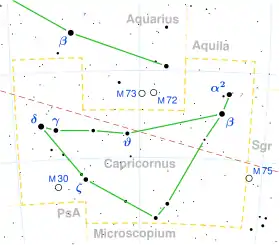Alpha1 Capricorni
Alpha1 Capricorni, Latinized from α1 Capricorni, is a distant likely multiple star system dominated by a highly luminous star in the constellation of Capricornus yet north of the ecliptic (including the averaged planetary plane and the path of the sun). It also has the traditional star names Prima Giedi /ˌpraɪmə ˈdʒiːdi/ and Algiedi Prima /æˈdʒiːdi ˈpraɪmə/. It is approximately 870 light years from the solar system. It is separated from the brighter Alpha2 Capricorni by 0.11° of the sky, a gap resolvable with the naked eye, similar to Mizar and Alcor and both are not to be confused with much fainter 3 Capricorni nor somewhat fainter Nu Capricorni which are 3 to 6 times the angular distance (arc) of that separating the two Alpha stars, respectively.
- For other star systems with this Bayer designation, see Alpha Capricorni.
 | |
| Observation data Epoch J2000.0 Equinox J2000.0 (ICRS) | |
|---|---|
| Constellation | Capricornus |
| Right ascension | 20h 17m 38.86987s[1] |
| Declination | −12° 30′ 25.5594″[1] |
| Apparent magnitude (V) | 4.27[2] |
| Characteristics | |
| Spectral type | G3 Ib[3] |
| U−B color index | +0.70[2] |
| B−V color index | +1.07[2] |
| Astrometry | |
| Proper motion (μ) | RA: 22.98 ± 0.32[1] mas/yr Dec.: 1.28 ± 0.28[1] mas/yr |
| Parallax (π) | 3.7417 ± 0.1990[4] mas |
| Distance | 870 ± 50 ly (270 ± 10 pc) |
| Absolute magnitude (MV) | −1.90[5] |
| Details[3] | |
| Mass | 5.3 M☉ |
| Luminosity | 1,047 L☉ |
| Temperature | 5,300 K |
| Metallicity [Fe/H] | +0.22 dex |
| Rotational velocity (v sin i) | 7.3 km/s |
| Other designations | |
| Database references | |
| SIMBAD | data |
α1 Capricorni has three faint possibly slow co-orbiting stars within one arc-minute, so unresolveable to small telescopes. The brightest of these is 10th magnitude and on this basis it has often been considered as an optical binary. Separation is increasing rapidly due to great proper motion of the primary star. The Hipparcos satellite in about the year 2000 found an undetected very close companion, 0.6" away and four magnitudes fainter.[7]
The primary star is a yellow G3 supergiant with an apparent magnitude of +4.3. This star has 5.3 times the mass of the Sun and is radiating around 1,047 times the Sun's luminosity.[3]
In popular culture
The name Giedi Prime is used for a fictional planet in Frank Herbert's 1965 science fiction novel Dune. This Giedi Prime is a planet of the star 36 Ophiuchi B, and is the home world of the villainous House Harkonnen.[8]
References
- van Leeuwen, F. (2007). "Validation of the New Hipparcos Reduction". Astronomy and Astrophysics. 474 (2): 653–64. arXiv:0708.1752. Bibcode:2007A&A...474..653V. doi:10.1051/0004-6361:20078357. S2CID 18759600.
- Ducati, J. R. (2002). "VizieR Online Data Catalog: Catalogue of Stellar Photometry in Johnson's 11-color system". CDS/ADC Collection of Electronic Catalogues. 2237: 0. Bibcode:2002yCat.2237....0D.
- Smiljanic, R.; et al. (April 2006), "CNO in evolved intermediate mass stars", Astronomy and Astrophysics, 449 (2): 655–671, arXiv:astro-ph/0511329, Bibcode:2006A&A...449..655S, doi:10.1051/0004-6361:20054377, S2CID 3711409
- Brown, A. G. A.; et al. (Gaia collaboration) (August 2018). "Gaia Data Release 2: Summary of the contents and survey properties". Astronomy & Astrophysics. 616. A1. arXiv:1804.09365. Bibcode:2018A&A...616A...1G. doi:10.1051/0004-6361/201833051. Gaia DR2 record for this source at VizieR.
- Anderson, E.; Francis, Ch. (2012), "XHIP: An extended hipparcos compilation", Astronomy Letters, 38 (5): 331, arXiv:1108.4971, Bibcode:2012AstL...38..331A, doi:10.1134/S1063773712050015, S2CID 119257644.
- Rumrill, H. B. (1936). "Star Name Pronunciation". Publications of the Astronomical Society of the Pacific. 48 (283): 139. Bibcode:1936PASP...48..139R. doi:10.1086/124681.
- Mason, Brian D.; Wycoff, Gary L.; Hartkopf, William I.; Douglass, Geoffrey G.; Worley, Charles E. (2001). "The 2001 US Naval Observatory Double Star CD-ROM. I. The Washington Double Star Catalog". The Astronomical Journal. 122 (6): 3466. Bibcode:2001AJ....122.3466M. doi:10.1086/323920.
- Herbert, Frank (1965). Dune. ISBN 978-0441172719.